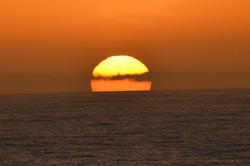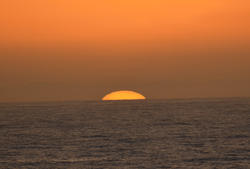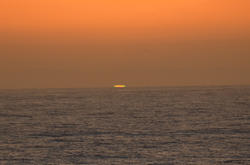 Some of you might have heard of the “green flash”—an upward flash of emerald-green light that appears for a few seconds just after the sun disappears beneath the horizon. It has a certain “wow effect” as this green light is a big surprise in a typical red-toned sunset. We were lucky enough to see it once while we were exploring the Rio Grande Rise in the South Atlantic.
Some of you might have heard of the “green flash”—an upward flash of emerald-green light that appears for a few seconds just after the sun disappears beneath the horizon. It has a certain “wow effect” as this green light is a big surprise in a typical red-toned sunset. We were lucky enough to see it once while we were exploring the Rio Grande Rise in the South Atlantic.
 So, what is happening here? When can we see this atmospheric optical phenomenon and why do we not see it more often?
So, what is happening here? When can we see this atmospheric optical phenomenon and why do we not see it more often?
White sunlight is a mixture of light of various colors and with variable wavelengths ranging from red (long wave length) to purple (shortest wave length). We can observe this range of colors in phenomena such as rainbows or when sunlight shines through a prism. At sunset the light rays travel a longer path through the atmosphere than when the sun stands higher in the sky. Light of different wavelengths interacts variably with the atmosphere. Blue and purple light are scattered the most. At sunset, mostly red and yellow light reaches our eye, and the sun appears red. (photo 1)
 In addition to being scattered, light is also bent in the atmosphere. The optical term for this is refraction. This is actually the effect that separates the different colors of light when we look at white light as it goes through a prism. At sunset, the atmosphere itself acts like a prism and breaks the sun’s white light into its constituent parts. The “green light” sun appears higher on the horizon than the “red light” sun. However, it shows up only as a green rim on the top of the sun (photo 2,3); when the full sun is in the sky, the bottom rim is actually red. The green rim appears on the top of the sun because the shorter wavelength green light is bent more by the atmosphere than the longer wavelength red light. This effect is small, though, and only visible with binoculars (NEVER look directly in the sun, you might injure your eyes!). We were able to look directly into the sun during the whole sunset due to a haze that weakened the intensity of the light. In principle, one should also see blue and purple rims above the green rim, but because blue and purple light is strongly scattered, we usually only see the green rim. The upper green rim of the sun was only made visible with the 300 mm zoom of the camera. (photo 2, 3)
In addition to being scattered, light is also bent in the atmosphere. The optical term for this is refraction. This is actually the effect that separates the different colors of light when we look at white light as it goes through a prism. At sunset, the atmosphere itself acts like a prism and breaks the sun’s white light into its constituent parts. The “green light” sun appears higher on the horizon than the “red light” sun. However, it shows up only as a green rim on the top of the sun (photo 2,3); when the full sun is in the sky, the bottom rim is actually red. The green rim appears on the top of the sun because the shorter wavelength green light is bent more by the atmosphere than the longer wavelength red light. This effect is small, though, and only visible with binoculars (NEVER look directly in the sun, you might injure your eyes!). We were able to look directly into the sun during the whole sunset due to a haze that weakened the intensity of the light. In principle, one should also see blue and purple rims above the green rim, but because blue and purple light is strongly scattered, we usually only see the green rim. The upper green rim of the sun was only made visible with the 300 mm zoom of the camera. (photo 2, 3)
 A green flash, however, is something special and is rarely seen, but it can be observed with the naked eye! As we watched the sun set, we all went “Wow!” when an emerald-green flash appeared for about 2 seconds just where the sun had disappeared (photo 4). To see a green flash requires a mirage in addition to an unobscured horizon. Normally the temperature and the density of the atmosphere decrease with height. Sun rays are refracted as they travel through the atmosphere. How much they refract depends on the density of the air; warm air refracts the most. When the air has layers of reversed density—for example when cooler air underlies warmer air—then a mirage can become visible. The almost vertical sides of the setting sun in Figures 2 and 3 are indicators that we are looking at a sequence of images of the sun that make it look like it is being stretched out. And that is exactly what the green flash is! It is basically a stretched out green rim magnified and made visible by stacked images produced by a mirage (photo 4). We were very lucky to have observed this magnificent green flash during our cruise!
A green flash, however, is something special and is rarely seen, but it can be observed with the naked eye! As we watched the sun set, we all went “Wow!” when an emerald-green flash appeared for about 2 seconds just where the sun had disappeared (photo 4). To see a green flash requires a mirage in addition to an unobscured horizon. Normally the temperature and the density of the atmosphere decrease with height. Sun rays are refracted as they travel through the atmosphere. How much they refract depends on the density of the air; warm air refracts the most. When the air has layers of reversed density—for example when cooler air underlies warmer air—then a mirage can become visible. The almost vertical sides of the setting sun in Figures 2 and 3 are indicators that we are looking at a sequence of images of the sun that make it look like it is being stretched out. And that is exactly what the green flash is! It is basically a stretched out green rim magnified and made visible by stacked images produced by a mirage (photo 4). We were very lucky to have observed this magnificent green flash during our cruise!
By Cornelia Class
- 1435 reads